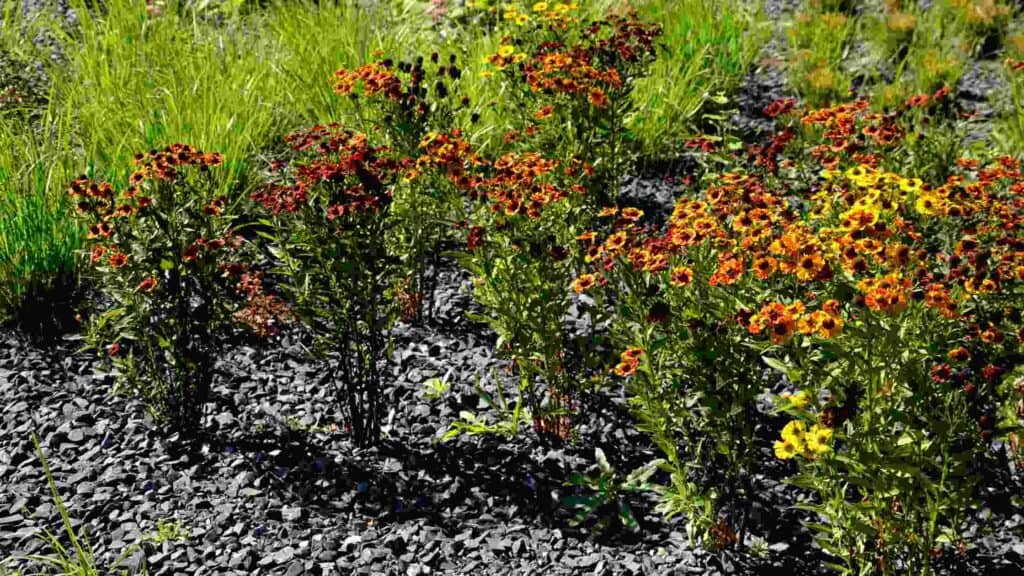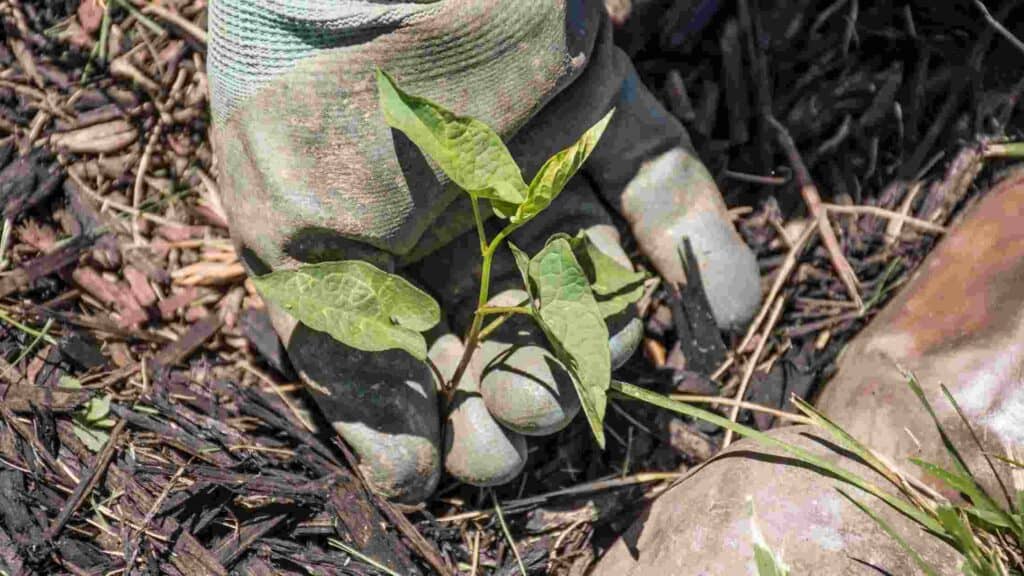In this article, let’s explore some essential strategies on how to keep weeds out of flower beds.
Flower gardens are a cherished sight for any gardening enthusiast. However, the unwelcome presence of weeds can turn the delight of gardening into a constant battle.
Dealing with these intruders can be quite frustrating, but there are effective methods to keep your flower beds relatively weed-free, making your gardening endeavors smoother and your plants healthier.
How To Keep Weeds Out Of Flower Beds
One of the best ways to keep weeds at bay is by strategic planting. By filling every available space between your flowers with ground-cover plants, you create less room for weeds to establish themselves.
Forget about leaving gaps in your plot; instead, allow your chosen plants to weave together, forming a dense and lush tapestry.
Plant your flowers close together, and consider digging deeper to provide ample room for the roots to grow downwards, minimizing their lateral spread.
How Do You Prevent Weeds From Growing In Your Flower Bed?
In gardening, just like in life, prevention is often better than cure. Ensuring that the soil you use is free from weed seeds is a crucial first step.
Embrace the method of crowding out and preventing weeds by cultivating thick plantings of both perennials and annuals. This approach not only discourages weed growth but also helps retain moisture in the soil, reducing the need for frequent watering.
As summer gives way to fall, consider dividing and splitting overgrown perennials to fill any open spaces in your flower beds.
Before planting new flowers, carefully inspect them to ensure no small weeds are lurking among them, removing any potential intruders. Additionally, opt for well-aged mulch, organic matter, or compost to avoid introducing weed seeds into your garden.
Weeds can be tenacious opportunists, quickly establishing themselves in flower beds with minimal competition. The freshly disturbed soil and open spaces in flower beds provide an ideal environment for weed growth.
On the other hand, well-maintained lawns with densely packed grass offer little room for weeds to flourish between the plants. However, issues may arise when weeds from a flower bed start invading a well-kept lawn (here’s how to fix a lawn full of weeds).
What To Use To Keep Weeds Out Of Flower Beds
To prevent weeds from infiltrating your lawn from the flower bed, a proactive approach is essential. Follow these steps to maintain the barrier effectively:
- Thorough Weeding: Start by meticulously removing as many weeds as possible from your flower bed. This initial cleanup significantly reduces the chances of weed invasion.
- Plastic Border: Install a plastic border along the edges of your flower bed. Make sure it can be pushed into the ground at least 2 to 3 inches deep, effectively preventing any weed runners from escaping into your lawn.
- Pre-Emergent Weed Killer: Apply a pre-emergent weed killer to both your flower beds and lawn. This preventive measure hinders weed seeds from germinating and taking root.
What Do You Put Down To Stop Weeds Coming Through?

Mulching goes beyond aesthetics; it’s a powerful tool in the fight against weed invasion. Proper application and maintenance of mulch can significantly reduce future weed growth.
Here’s how to make the most of this natural shield:
- The Right Depth: Aim for a layer of 4 to 6 inches of organic mulch in your flower beds. This thickness effectively prevents weed growth and maintains soil moisture (find out the best soil moisture meters).
- Handle with Care: Once you’ve laid down your mulch, resist the urge to rake or disturb it regularly. Doing so might inadvertently introduce dormant weed seeds to the surface, leading to fresh weed growth.
- Strategic Freshening: Instead of turning your mulch, consider adding a thin layer to freshen up the beds. This approach maintains the barrier while giving your flower garden a polished look.
You may also be interested in learning how to keep weeds out of mulch.
How To Keep Weeds Out Of Flower Beds With Newspaper
In the quest for a weed-free flower garden, one simple and cost-effective method stands out: newspapering. By depriving unwanted weeds of light, you can keep them at bay and maintain the beauty of your flower beds.
Here’s how to utilize this ingenious technique to your advantage:
Step 1: Clear the Way
Before laying down the newspaper, ensure that your flower bed is free from existing weeds. Thoroughly remove any unwanted plants to create a clean canvas for your gardening endeavors.
Step 2: Stack and Cover
Take 8 to 10 sheets of newspaper and stack them on top of each other within the flower bed. If you happen to run out of newspapers, wet cardboard works just as effectively. This natural barrier will effectively smother the weeds beneath it.
Step 3: Mulching
To further fortify your defenses against weeds, cover the newspaper with a generous layer of mulch. Mulching not only smothers weeds but also helps the soil retain essential moisture, providing a nurturing environment for your beloved flowers.
You may also be interested in finding out what to do with old mulch in the garden.
Benefits Of Using Newspapers
The newspapering technique offers a range of benefits, making it a win-win solution for both your garden and the environment:
- Soil conditioning: As the newspaper decomposes, it contributes to soil conditioning, leaving it soft and loose for next year’s planting endeavors.
- Recycling newspapers: By using old newspapers, you contribute to recycling efforts, reducing waste, and giving a new purpose to these paper products.
- Cheapest way to keep weeds out of garden: Compared to landscape fabric, newspapering proves to be a more budget-friendly option, delivering excellent results without breaking the bank.
- Attracting earthworms: Your garden will attract a thriving population of earthworms, which play a vital role in maintaining healthy soil.
Hand Weeding: How To Keep Weeds Out Of Flower Beds Naturally

For precision and efficacy in weed removal, hand weeding is the way to go. Follow these tips to make hand weeding a success:
- Complete Root Removal: Ensure you remove the entire root of the weed to prevent regrowth.
- Stay Regular: Make a habit of weeding regularly to catch small weed seedlings before they mature.
- Sun-Dry Strategy: On a hot day, use a hoe or pronged fork weeder to scratch the soil surface, exposing small seedlings to the sun. The heat will quickly dry them out, halting their growth.
- Persistent Efforts: For weeds with deep roots or rhizomes, keep cutting them as low as possible. Consistent weeding over a period of 9 to 13 sessions within two years can lead to weed eradication.
- Sanitize Your Tools: After each weeding session, sterilize your tools with rubbing alcohol or alcohol wipes to prevent the transfer of weed seeds or diseases to other parts of your garden.
Chemical Solutions With Caution
While chemical herbicides may seem like a quick fix, they come with potential risks. To minimize any adverse effects on your flowers, birds, or pets, consider these cautious steps:
- Start Mild: Begin with the mildest products, such as vinegar-based liquids, corn gluten meal, or herbicidal soaps, following package instructions.
- Targeted Approach: Choose chemical herbicides specifically designed for the weeds in your garden and use them strictly according to the manufacturer’s directions.
By combining these strategies and maintaining diligence in your gardening practices, you can effectively combat weeds and create a flourishing haven of beauty in your flower beds. Remember, nurturing your garden is a labor of love, and the rewards are well worth the effort.
Heat Treatment: A Pre-Planting Weed Elimination
If you have a larger garden area and ample time before planting, heating the soil can be a potent weed eradication method. Follow these steps for effective results:
- Till and Prepare: Begin by tilling the soil in the designated bed, creating a smooth and even surface (find out the best weeding tool).
- Cover Up: Lay clear, heavy-gauge plastic over the soil and weigh down the edges to secure it in place.
- Keep Moist: Ensure the area stays moist, aiding the heating process.
- Time is Key: Allow approximately 8 weeks for the soil to heat sufficiently to kill off weed seeds.
FAQs
1. What is the best thing to kill weeds in flower beds?
The best thing to kill weeds in flower beds is by using a targeted herbicide (here is the best weed killer for lawns) or manually pulling them.
2. What kills weeds but won’t kill flowers?
A selective herbicide that targets only weeds and not flowers can effectively kill weeds without harming the flowers.
3. How to permanently stop weeds from growing?
To permanently stop weeds from growing, a combination of methods like mulching, regular weeding, and using pre-emergent herbicides can be effective.
4. How to stop weeds from growing through landscape fabric?
To prevent weeds from growing through landscape fabric, ensure proper installation with overlapping edges and cover it with mulch.
5. What is the best way to keep grass and weeds out of flower beds?
The best way to keep grass and weeds out of flower beds is by using mulch, regular weeding, and applying a pre-emergent herbicide. Find out our top pick for the best corded electric weed eater.
6. How to keep grass out of flower beds?
To keep grass out of flower beds, install edging to create a barrier and regularly pull out any invading grass.
7. How to prevent weeds from growing in rocks?
To prevent weeds from growing in rocks, use a weed barrier or landscape fabric beneath the rocks and apply an appropriate herbicide for any persistent weeds.
Read more about what to put under rocks to prevent weeds.
Conclusion
Maintaining weed-free flower beds doesn’t have to be an arduous task. By employing eco-friendly and strategic methods such as newspapering, mulching, and hand weeding, gardeners can effectively keep unwanted intruders at bay.
Embracing these techniques not only helps create a picturesque and well-maintained garden but also contributes to the health of the soil and local ecosystem. Remember, a little persistence and regular maintenance go a long way in ensuring that your beloved flowers thrive in a weed-free haven.
So, roll up your sleeves, enjoy the therapeutic act of gardening, and let your flower beds flourish with the vibrant beauty they deserve. Happy gardening!
